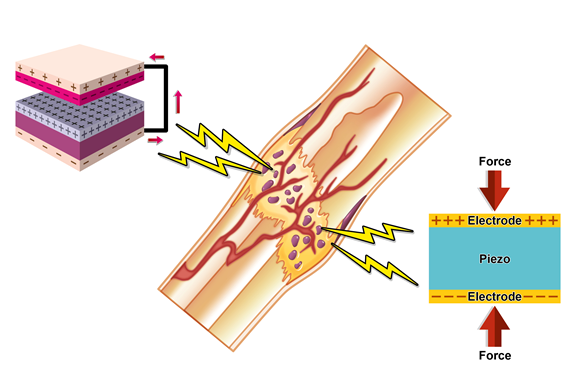Feb 18 2020
Some materials show promise promoting bone regeneration by enhancing its natural electrical properties, according to a review in the journal Science and Technology of Advanced Materials.

Triboelectric nanogenerators (left) and piezoelectric materials (right) are being investigated for their potential to improve bone’s natural healing properties. Copyright: NIMS
Some solids, including bone, enamel and quartz, form an electric field when deformed. This property, called the piezoelectric effect, happens when a mechanical force pushes atoms closer together or further apart, upsetting the electric balance and causing positive and negative charges to appear on opposite sides of a material.
Scientists discovered that bone was a piezoelectric material in 1957. Since then, they have found that piezoelectricity occurs when bone collagen fibers slide against each other. This leads to the accumulation of charges and the generation of a tiny current, which opens up calcium ion channels in bone cells called osteocytes. This triggers a cascade of signaling pathways that ultimately promote bone formation.
“Piezoelectricity is one of several mechanical responses of the bone matrix that allows bone cells to react to changes in their environment,” explain biomedical engineer Zong-Hong Lin of Taiwan’s National Tsing Hua University and medical doctor Fu-Cheng Kao of Taiwan’s Chang Gung Memorial Hospital, who led the review.
Researchers are seeking to leverage this property to improve bone regeneration and repair. For example, they are exploring materials to fabricate tiny, self-powered electric generators that can be implanted inside or outside bone to stimulate its natural healing processes.
Some teams have significantly accelerated the proliferation and differentiation of mouse embryonic bone-forming cells when using a so-called triboelectric nanogenerator. An electric current is generated when two materials are separated and then brought back into contact. These nanogenerators have been tested with materials such as polydimethylsiloxane, indiumtin oxide, aluminum, and polytetrafluoroethylene. They are showing potential for treating osteoporosis and osteoporosis-related fractures.
Piezoelectric nanogenerators, on the other hand, are made by connecting an electrode to a piezoelectric material on a flexible substrate, and generate a current when force is applied. These nanogenerators have also been shown to promote the proliferation of human bone-forming cells.
Besides nanogenerators, piezoelectric polymers, which have good biocompatibility with human tissues, are showing promise as absorbable screws and pins in severe bone fractures, helping avoid a second surgery for their removal.
Piezoelectric ceramics provide stronger electric currents compared to polymers, but can be toxic. Non-lead-based ceramics, like barium titanate, hydroxyapatite, and zinc oxide are leading candidates for bone scaffolds that promote bone growth and regeneration and for artificial bone substitutes.
Lin and his colleagues expect further research will lead to piezoelectricity-based applications for tissue engineering and bone regeneration.
Source: http://nthu-en.web.nthu.edu.tw/